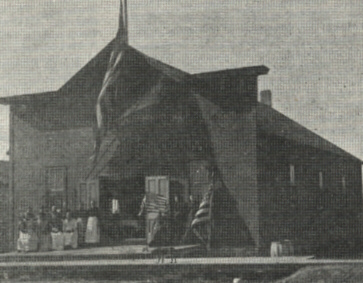The Stocker Blacksmith Shop, in Gettysburg, SD is in need of immediate repairs. This shop is on the National Park Service Register of Historic Places, unfortunately it is up to the community to preserve and protect this valuable piece of history. Please read the following article that was published in the October 19 issue of the Potter County News.

Here is a view of the W.R.C. Hall erected in 1907 by an ambitious and active Women's Relief Corps, which was disbanded a few years before Gettysburg's Fiftieth Anniversary. In those days, the hall was one of the centers of community activities and was also used by some of the religious organizations for church services.
Funds for erecting the building were received through donations and through various activities of the Relief Corps.
In 1920 it was sold to G. L.Stocker for a blacksmith shop. Today, in 1958, Mr. Stocker is still using it for that purpose, one of the few oldtime blacksmith shops left in the country.
(Reprinted from Gettysburg South Dakota, 75th Anniversary, page 11)

This photograph, taken in 1998 shows how the roof is beginning to sag.
The following article is to be printed in the Oct. 19, 2000 edition of the Potter County News
| Newspaper photo not available |
Pictured above is the Meade WRC Hall, Gettysburg, SD, in the early 1990s when the Potter County Historical Association placed a historical marker. At the dedication were Tom Schlacter, Dorothy & Harrison Wilson, Coe Frankhauser and Winifred Fawcett.
In 1995 this property was placed on the National Register of Historic Places by the United States Department of Interior.
The Meade WRC Hall is better known as the Lee Stocker Blacksmith Shop. It was erected in 1907 by an ambitious and active Women's Relief Corps. That group was the women's counterpart to the Civil War Veteran's organization known as GAR or Grand Army of the Republic. Funds for erecting the building were received through donations and various activities of the Relief Corps. It was one of the centers of the community activities and was also used by several religious organizations for church services.
The WCR disbanded a few years before Gettysburg's 50th Anniversary in 1933. Prior to that time, the Hall had been sold to G. L. Stocker for a blacksmith shop.
Part of an article written in 1983 by Stocker's daughter, Velma Miller, for Gettysburg's Centennial Book is as follow:
"My parents, Lee and Carrie (Glosser) Stocker, came to South Dakota from Blakesburg, Iowa in 1902, with their three small daughters, Alma, Olive and Lulu. Dad found a job running a steam threshing machine near Wolsey. They intended to farm and in a short time had found one to rent. However, the threshing job ended before the farm was available. Luckily, their landlord found work for Dad in a blacksmith shop in Huron, and his employer was able to convince him that he should continue blacksmithing and forget about farming.
At the time, Gettysburg was in need of a blacksmith and in some way, John McMaster and Jake Houck heard about Dad. It was through their encouragement that he moved his family to Gettysburg in 1907. He set up his shop in the corner building recently vacated by Nagel Motors. He made much of the equipment that he used, including his triphammer, lathe, forge, hammers, etc. At that time blacksmithing was a booming business. He had customers from a vast territory, some from as far as 100 miles west and others even sent worked by train from Sioux Falls. He worked long hard hours taking care of his patron's needs. In 1920 he purchased the old WRC Hall and moved his business there.
He worked steadily until 1966, a period of over sixty years, at his trade."
Lee Stocker (1873 - 1970) is still remembered by many people in this area for his work at the blacksmith shop. He was probably one of the last of his trade in the country.
As a child in the early 1950s, Alfred Nagel remembers sitting around the pot bellied stove at the blacksmith shop that was decorated with an assortment of Prince Albert tobacco cans. He and Dough Stroh would go there after school in the winter and listen to Lee Stocker tell stories. Alfred also remembers how strong Mr. Stocker must have been. Lee would lift 16 inch red-hot plow lays with his blacksmith tongs and beat them out with his special tools.
Grant money procured several years ago is available and will cover approximately half of the amount need to preserve the blacksmith shop from further deterioration. Most immediate is the need for a new roof which must be done this fall to protect the irreplaceable handmade blacksmith tools.
Any interested party's assistance in this preservation project would be greatly appreciated. Give your name to the Dakota Sunset Museum, 765-9480.